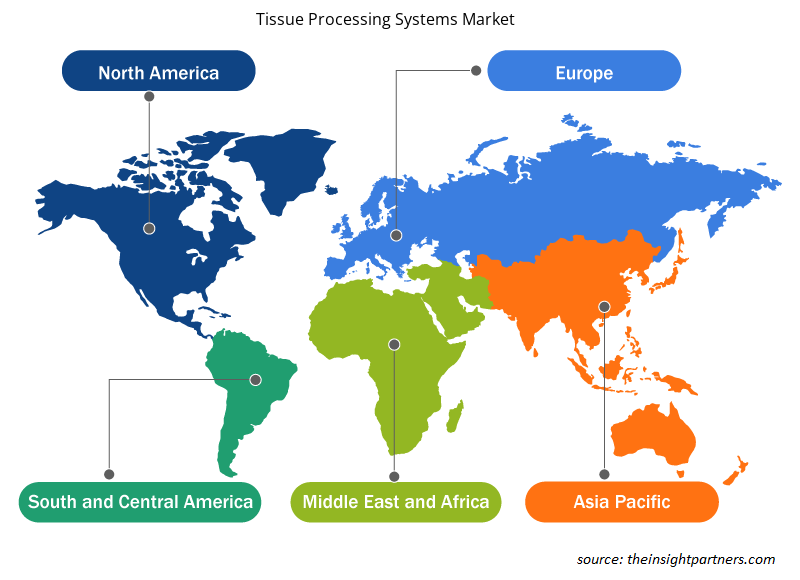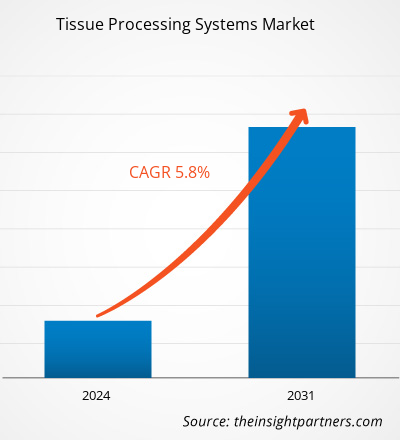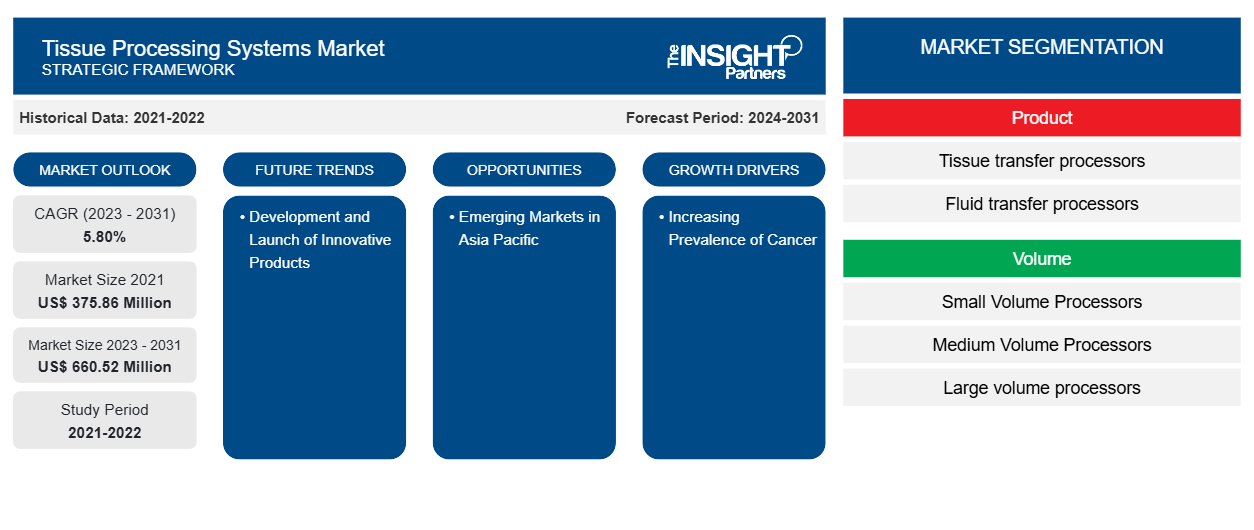Se estimó que el mercado de sistemas de procesamiento de tejidos sería de 375,86 millones de dólares estadounidenses en 2021 y de xx millones de dólares estadounidenses en 2023. Se espera que alcance los 660,52 millones de dólares estadounidenses en 2031 y registre una CAGR del 5,80 % hasta 2031. Las preferencias cambiantes de los consumidores y los avances tecnológicos probablemente seguirán siendo tendencias clave del mercado de sistemas de procesamiento de tejidos.
Análisis del mercado de sistemas de procesamiento de tejidos
Se espera que la creciente prevalencia del cáncer impulse el crecimiento del mercado de sistemas de procesamiento de tejidos. Se espera que la creciente prevalencia del cáncer aumente la demanda de sistemas de procesamiento de tejidos para el diagnóstico. Según la agencia de cáncer de la Organización Mundial de la Salud (OMS), la Agencia Internacional para la Investigación sobre el Cáncer (IARC), en 2022, hubo aproximadamente 20 millones de nuevos casos de cáncer y alrededor de 9,7 millones de muertes.
Descripción general del mercado de sistemas de procesamiento de tejidos
El mercado mundial de sistemas de procesamiento de tejidos está segmentado por región en América del Norte, Europa, Asia Pacífico, Oriente Medio y África, y América del Sur y Central. Se espera que el mercado crezca en esta región debido a factores como la creciente prevalencia del cáncer y el creciente número de laboratorios de diagnóstico . Sin embargo, se espera que el alto costo de los diagnósticos de cáncer obstruya el crecimiento del mercado hasta cierto punto durante los años de pronóstico.
Personalice este informe según sus necesidades
Obtendrá personalización en cualquier informe, sin cargo, incluidas partes de este informe o análisis a nivel de país, paquete de datos de Excel, así como también grandes ofertas y descuentos para empresas emergentes y universidades.
-
Obtenga las principales tendencias clave del mercado de este informe.Esta muestra GRATUITA incluirá análisis de datos, desde tendencias del mercado hasta estimaciones y pronósticos.
Impulsores y oportunidades del mercado de sistemas de procesamiento de tejidos
Creciente número de laboratorios de diagnóstico favorecerá el mercado.
Hay un aumento en el número de laboratorios de diagnóstico, debido al aumento de las enfermedades crónicas. El aumento de enfermedades crónicas, como el cáncer, la diabetes y las enfermedades cardíacas, conduce a una mayor demanda de servicios de diagnóstico. Los Centros de Servicios de Medicare y Medicaid regulan todas las pruebas de laboratorio realizadas en humanos en los EE. UU. a través de las Enmiendas de Mejora de Laboratorios Clínicos (CLIA). CLIA tiene aproximadamente 317,545 laboratorios registrados (exentos/no exentos) a marzo de 2024. Además, es probable que la presencia de importantes laboratorios de diagnóstico en los EE. UU. favorezca el crecimiento del mercado. Por ejemplo, Quest Diagnostics es líder en la industria del diagnóstico médico que ofrece servicios de diagnóstico en los EE. UU. Es la red más extensa de los EE. UU., con más de 7400 puntos de acceso para pacientes, que incluyen flebotomistas en consultorios médicos y más de 2250 centros de servicio para pacientes.
Mercados emergentes en Asia Pacífico: una oportunidad en el mercado de sistemas de procesamiento de tejidos
Los mercados emergentes de los países en desarrollo de la región de Asia y el Pacífico están creando mejores oportunidades para que los actores importantes del mercado amplíen sus negocios. Esta es una de las principales razones del crecimiento del mercado en el período de pronóstico. La mayoría de los actores principales se centran en los mercados emergentes, como India y China, debido al gran número de pacientes con cáncer y al aumento del turismo médico en los países en desarrollo. Muchos de los países emergentes son un lugar preferido para el turismo médico.
Según Globocan 2022: India Factsheet, hubo 1.413.316 nuevos casos de cáncer y 916.827 muertes por cáncer en 2022. Además, es probable que el aumento del turismo médico en los países emergentes y la creciente prevalencia de enfermedades crónicas en la región brinden importantes oportunidades de crecimiento a los actores que operan en el mercado durante el período de pronóstico.
Análisis de segmentación del informe de mercado de sistemas de procesamiento de tejidos
Los segmentos clave que contribuyeron a la derivación del análisis del mercado de sistemas de procesamiento de tejidos son los servicios y las aplicaciones.
- Según el producto, el mercado de sistemas de procesamiento de tejidos se segmenta en procesadores de transferencia de tejidos y procesadores de transferencia de fluidos. El segmento de procesadores de transferencia de fluidos tuvo la mayor participación del mercado, mientras que se prevé que el segmento de procesadores de transferencia de tejidos registre la CAGR más alta del mercado durante el período de pronóstico.
- El mercado está segmentado por volumen en procesadores de pequeño volumen, procesadores de volumen medio y procesadores de gran volumen. El segmento de pequeño volumen tuvo la mayor participación del mercado en 2023. Sin embargo, se prevé que el segmento de volumen medio registre la CAGR más alta del mercado durante el período de pronóstico.
- Por usuario final, el mercado de sistemas de procesamiento de tejidos se ha segmentado en hospitales, compañías farmacéuticas, laboratorios de investigación y otros. El segmento de hospitales tuvo la mayor participación del mercado, mientras que se estima que el segmento de compañías farmacéuticas registrará la CAGR más alta del mercado durante el período de pronóstico.
Análisis de la cuota de mercado de los sistemas de procesamiento de tejidos por geografía
El alcance geográfico del informe de mercado de sistemas de procesamiento de tejidos se divide principalmente en cinco regiones: América del Norte, Asia Pacífico, Europa, Medio Oriente y África, y América del Sur / América del Sur y Central.
América del Norte incluye a Estados Unidos, Canadá y México. El mercado de América del Norte tuvo una participación significativa del mercado mundial durante el año 2023. Se prevé que la demanda del mercado en la región experimente un crecimiento a un ritmo significativo durante el período de pronóstico debido a varios factores, como el aumento de la prevalencia del cáncer, junto con una mayor conciencia sobre la condición de salud crónica, así como la presencia de asociaciones de apoyo en la región. Hubo muchas organizaciones que participaron en las inversiones y crearon conciencia sobre el cáncer y su diagnóstico.
La región de Asia Pacífico es el mercado de sistemas de procesamiento de tejidos que crece más rápidamente en un escenario global debido al envejecimiento de la población, el aumento de los casos de cáncer, los avances tecnológicos y las crecientes iniciativas gubernamentales para ofrecer atención médica avanzada y asequible, y el creciente número de empresas emergentes y de dispositivos médicos en esta región. Además, la creciente incidencia y las tasas de mortalidad por cáncer, las actividades de investigación en la región y la presencia de asociaciones u organizaciones que mejoran la calidad de la atención en el cáncer también contribuyen al crecimiento del mercado.
Perspectivas regionales del mercado de sistemas de procesamiento de tejidos
Los analistas de Insight Partners explicaron en detalle las tendencias y los factores regionales que influyen en el mercado de sistemas de procesamiento de tejidos durante el período de pronóstico. Esta sección también analiza los segmentos y la geografía del mercado de sistemas de procesamiento de tejidos en América del Norte, Europa, Asia Pacífico, Oriente Medio y África, y América del Sur y Central.

- Obtenga datos regionales específicos para el mercado de sistemas de procesamiento de tejidos
Alcance del informe de mercado de sistemas de procesamiento de tejidos
| Atributo del informe | Detalles |
|---|---|
| Tamaño del mercado en 2021 | US$ 375,86 millones |
| Tamaño del mercado en 2031 | US$ 660,52 millones |
| Tasa de crecimiento anual compuesta (CAGR) global (2023-2031) | 5,80% |
| Datos históricos | 2021-2022 |
| Período de pronóstico | 2024-2031 |
| Segmentos cubiertos |
Por producto
|
| Regiones y países cubiertos |
América del norte
|
| Líderes del mercado y perfiles de empresas clave |
|
Densidad de actores del mercado de sistemas de procesamiento de tejidos: comprensión de su impacto en la dinámica empresarial
El mercado de sistemas de procesamiento de tejidos está creciendo rápidamente, impulsado por la creciente demanda de los usuarios finales debido a factores como la evolución de las preferencias de los consumidores, los avances tecnológicos y una mayor conciencia de los beneficios del producto. A medida que aumenta la demanda, las empresas amplían sus ofertas, innovan para satisfacer las necesidades de los consumidores y aprovechan las tendencias emergentes, lo que impulsa aún más el crecimiento del mercado.
La densidad de actores del mercado se refiere a la distribución de las empresas o firmas que operan dentro de un mercado o industria en particular. Indica cuántos competidores (actores del mercado) están presentes en un espacio de mercado determinado en relación con su tamaño o valor total de mercado.
Las principales empresas que operan en el mercado de sistemas de procesamiento de tejidos son:
- Tecnologías Agilent Inc.,
- Laboratorios Biogenex,
- Sakura Finetek Usa Inc.,
- Thermo Fisher Scientific Inc.,
- F. Hoffmann-La Roche AG,
- Siemens Ag,
Descargo de responsabilidad : Las empresas enumeradas anteriormente no están clasificadas en ningún orden particular.

- Obtenga una descripción general de los principales actores clave del mercado de sistemas de procesamiento de tejidos
Noticias y desarrollos recientes del mercado de sistemas de procesamiento de tejidos
El mercado de sistemas de procesamiento de tejidos se evalúa mediante la recopilación de datos cualitativos y cuantitativos posteriores a la investigación primaria y secundaria, que incluye publicaciones corporativas importantes, datos de asociaciones y bases de datos. A continuación, se incluye una lista de los avances en el mercado de sistemas de procesamiento de tejidos y estrategias:
- En agosto de 2023, Sakura Finetek USA lanzó dos nuevos productos de la marca Tissue-Tek Genie que permiten realizar pruebas CISH en el sistema de tinción avanzado Tissue-Tek Genie. (Fuente: Comunicado de prensa de la empresa)
- En febrero de 2023, Clarapath, una empresa de robótica, adquirió Crosscope. La adquisición combina SectionStar de Clarapath, el primer sistema de seccionamiento y transferencia de tejidos totalmente automatizado y todo en uno, con las herramientas de patología computacional y de flujo de trabajo de Crosscope, lo que permite a los laboratorios brindar atención médica de manera más rápida, más rentable y con mayor calidad. (Fuente: Comunicado de prensa de la empresa)
Informe de mercado sobre sistemas de procesamiento de tejidos: cobertura y resultados
El informe “Tamaño y pronóstico del mercado de sistemas de procesamiento de tejidos (2021-2031)” proporciona un análisis detallado del mercado que cubre las siguientes áreas:
- Tamaño del mercado y pronóstico a nivel global, regional y nacional para todos los segmentos clave del mercado cubiertos bajo el alcance
- Dinámica del mercado, como impulsores, restricciones y oportunidades clave
- Principales tendencias futuras
- Análisis detallado de las cinco fuerzas de Porter y PEST y FODA
- Análisis del mercado global y regional que cubre las tendencias clave del mercado, los principales actores, las regulaciones y los desarrollos recientes del mercado.
- Análisis del panorama de la industria y de la competencia que abarca la concentración del mercado, el análisis de mapas de calor, los actores destacados y los desarrollos recientes
- Perfiles detallados de empresas
- Análisis histórico (2 años), año base, pronóstico (7 años) con CAGR
- Análisis PEST y FODA
- Tamaño del mercado, valor/volumen: global, regional y nacional
- Industria y panorama competitivo
- Conjunto de datos de Excel
Informes recientes
Testimonios
Razón para comprar
- Toma de decisiones informada
- Comprensión de la dinámica del mercado
- Análisis competitivo
- Información sobre clientes
- Pronósticos del mercado
- Mitigación de riesgos
- Planificación estratégica
- Justificación de la inversión
- Identificación de mercados emergentes
- Mejora de las estrategias de marketing
- Impulso de la eficiencia operativa
- Alineación con las tendencias regulatorias























 Obtenga una muestra gratuita para - Mercado de sistemas de procesamiento de tejidos
Obtenga una muestra gratuita para - Mercado de sistemas de procesamiento de tejidos